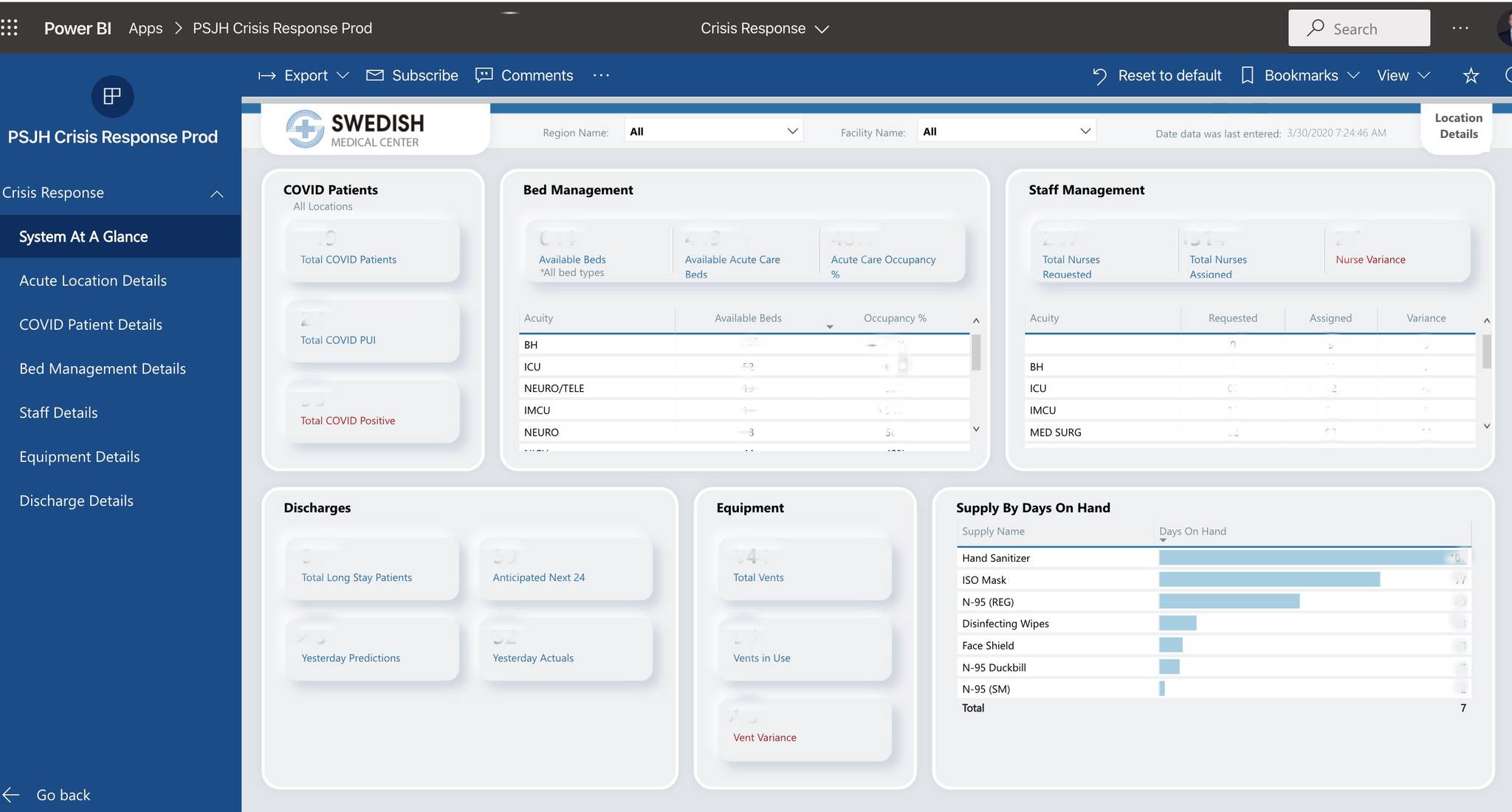Health care systems are filled with data — from the number of patients in a hospital at a given time and the number of beds available for patients, to equipment availability and staff allocation.
As the COVID-19 crisis emerged in the Puget Sound region, officials at Swedish Health Services realized they didn’t have a central location where healthcare workers could find all the information they needed. So they reached out to Microsoft in Redmond and together, the two launched the COVID-19 Emergency Response App (CERA).
Kevin Brooks, chief operating officer of Swedish First Hill Campus in Seattle, said during the early days of the outbreak, they did not know where they would be treating patients, whether it would be in tents or in their existing facilities. The medical provider’s information infrastructure at the time was not built to change quickly, and they needed a system that was flexible and would provide real-time feedback.
“That’s how we built [CERA]” Brooks said.
Better transparency
With the app, hospital workers can enter current information on their mobile devices. That information then populates dashboards for hospital leaders to view.
“Swedish is using these dashboards to track the status of each of its five acute-care hospitals, two free-standing emergency departments and individual units in critical areas, including COVID-19 patient volumes, occupancy, staffing, discharge management, ventilator utilization and [personal protection equipment (PPE)] management,” according to a press release.
In terms of staffing, CERA looks at nurses. Brooks said with their primary focus on addressing their strain on resources, the app allows them to see their current COVID-19 patient volumes and how many nurses are working at any given Swedish location.
Swedish has locations throughout the Puget Sound region including in Redmond and Issaquah on the Eastside; Ballard, Cherry Hill and First Hill in Seattle; and Edmonds and Everett in Snohomish County.
Brooks said with CERA, they can find capacity within the Swedish system. For example, if the Edmonds and Issaquah locations are full, they can see which locations have room to take in patients and transfer them there.
Brooks said at any given time, there are between 80 and 120 patients in their hospitals who do not have a medical necessity to be in a hospital. And if hospitals receive a surge of COVID-19 patients, using CERA, healthcare leaders can identify the number of non-COVID patients and discharge them to an appropriate level of care in order to create capacity for the COVID-19 patients.
For Swedish, the greatest benefit of CERA has been their gains in situational awareness and PPE management, Brooks said. Healthcare workers now know how many “days on hand” they have when it comes to supplies. Days on hand, he said, is how many days worth of supplies a hospital has based on its burn-through rate.
“It helps us be transparent with our team,” Brooks said about CERA.
Ryan Cunningham, director of Microsoft Power Apps (the company’s low-code application development platform), said the app includes a companion “admin app” that makes everything easily configurable, so bringing a new location online or adding new supplies doesn’t require any code change.
A close collaboration
Brooks and his team reached out to Microsoft on Friday, March 13, and they had the first version of the app in the hands of nurses by the following Monday.
Cunningham said within two weeks, Swedish rolled out the app more broadly. In addition, Microsoft has produced a generic version so any healthcare provider can use it.
“We quickly realized that Swedish was not the only healthcare provider with the need for better visibility over critical resource usage during this crisis,” Cunningham said. “We published the solution publicly late last month, and since then a number of organizations around the world have installed it to help them manage resources during the COVID-19 pandemic.”
The collaboration between Swedish and Microsoft was extremely close, he said.
“Given the urgency of the situation, both teams worked together around the clock,” Cunningham said. “Swedish experts were incredibly helpful sharing the details of their existing processes and providing fast feedback on how this could improve their efficiency. Kevin’s team offered needed context in the operations and needs of a modern hospital system.”
He said because Power Apps dramatically shortens the time for traditional app development, they were able to cut out a lot of the traditional back and forth of a software development process. Most of the feedback and iteration happened on live versions of the app that were updated multiple times per day.
This is not the first time Microsoft has partnered with the healthcare industry. Cunningham said some of their collaborations have included working with Walgreens Boots Alliance, Providence St. Joseph and Novartis.
Talk to us
Please share your story tips by emailing editor@kentreporter.com.
To share your opinion for publication, submit a letter through our website https://www.kentreporter.com/submit-letter/. Include your name, address and daytime phone number. (We’ll only publish your name and hometown.) Please keep letters to 300 words or less.

